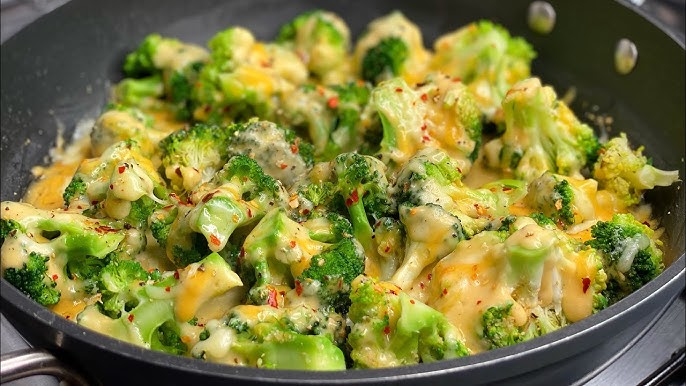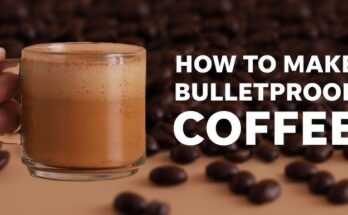Broccoli and Cheese Recipe: Is there anything more comforting than the warm, gooey goodness of cheese wrapped around tender broccoli? Probably not! Broccoli and cheese is that magical combo that makes even the pickiest eaters reach for seconds. This dish has stood the test of time—served as a cozy side, a vegetarian main course, or a kid-friendly crowd-pleaser. The richness of the cheese balances out the mild, earthy taste of broccoli perfectly, making it a match made in culinary heaven.
What’s even better? It’s quick, simple, and budget-friendly. You don’t need to be a Michelin-star chef to nail this recipe. Whether you’re planning a cozy dinner at home or need a side dish that wows your guests, this classic recipe has your back.
And don’t forget how versatile it is—you can make it in a skillet, bake it in the oven, or even turn it into a soup. But for today’s guide, we’re going with the ultimate baked broccoli and cheese dish. Think golden-brown top, creamy center, and that satisfying cheesy pull—ready to get started?
Nutritional Value of Broccoli and Cheese
Before we dive into the cooking process, let’s appreciate the health benefits hiding beneath that cheesy surface. Broccoli is a powerhouse of vitamins—packed with Vitamin C, Vitamin K, fiber, and antioxidants. It’s known to support heart health, improve digestion, and even offer some protection against certain types of cancer.
Cheese, when consumed in moderation, brings protein and calcium to the table. Sure, it’s rich, but when paired with a low-carb veggie like broccoli, it creates a satisfying and relatively balanced dish. You can always opt for low-fat cheese versions or plant-based options to keep things even lighter.
So yes, while this recipe screams comfort food, it’s also loaded with nutrients your body will thank you for.
Ingredients You’ll Need
Fresh Ingredients List
Let’s keep things simple and tasty. Here’s what you’ll need:
- 4 cups fresh broccoli florets (you can use frozen if needed)
- 2 tablespoons unsalted butter
- 2 tablespoons all-purpose flour
- 1 cup whole milk
- 1 cup shredded sharp cheddar cheese
- ½ teaspoon garlic powder
- Salt and pepper to taste
- ¼ cup grated Parmesan cheese (optional but recommended for topping)
This recipe serves about 4-6 people, depending on how much they love cheese (spoiler: it’s probably a lot).
Optional Add-ons to Elevate the Flavor
Want to take things up a notch? Here are some flavor-boosting extras:
- A pinch of red pepper flakes for heat
- Crumbled bacon for added crunch and flavor
- A dash of Dijon mustard in the cheese sauce for a tangy kick
- Breadcrumb topping for that golden crust
- A sprinkle of nutmeg for depth in the cheese sauce
These aren’t mandatory, but they can turn your broccoli and cheese from “yum” to “WOW.”
Equipment You’ll Need
Kitchen Tools for a Smooth Cooking Process
You don’t need a high-end kitchen setup—just the basics:
- Large pot (for blanching broccoli)
- Medium saucepan (for making cheese sauce)
- Whisk (for lump-free sauce)
- Baking dish (ceramic or glass works best)
- Cutting board and sharp knife
- Cheese grater
Having these ready before you start saves time and stress, letting you enjoy the process instead of scrambling around for tools mid-recipe.
Preparing Your Ingredients
Washing and Cutting the Broccoli
Start by rinsing your broccoli thoroughly under cold water. Make sure to remove any dirt or residue, especially if it’s farm-fresh. Pat it dry with a kitchen towel.
Next, cut the broccoli into bite-sized florets. Try to keep the sizes even so they cook uniformly. If you’re using the stems (and you should, they’re nutritious!), peel the tough outer layer and slice them into thin pieces.
Proper prep ensures the broccoli is tender, not mushy, and holds up well when mixed with cheese sauce.
Grating the Cheese for Maximum Meltability
Here’s a golden rule: grate your cheese fresh. Pre-shredded cheese might be convenient, but it usually contains anti-caking agents that affect melting. Freshly grated cheddar melts into that dreamy, velvety texture you’re aiming for.
Use the coarse side of your grater for cheddar and a finer side for Parmesan if you’re adding it as a topping.
Once everything’s prepped, you’re ready to cook!
Step-by-Step Cooking Instructions
Step 1 – Blanching the Broccoli
Blanching is the secret to keeping broccoli bright green and perfectly tender without turning it into mush. Here’s how you do it:
- Bring a large pot of water to a boil.
- Add a generous pinch of salt—this helps season the broccoli from the inside out.
- Drop in your broccoli florets and let them cook for just 2-3 minutes.
- Immediately transfer the broccoli to a bowl of ice water. This stops the cooking process and locks in that vibrant green color.
Once cooled, drain and set aside. Your broccoli should still have a little bite to it—trust me, that texture will be perfect once it bakes in the cheese sauce.
Step 2 – Making the Cheese Sauce
This is where the magic happens. We’re going to make a simple roux-based cheese sauce that’s rich, creamy, and full of flavor.
- In a medium saucepan, melt 2 tablespoons of butter over medium heat.
- Whisk in 2 tablespoons of flour, stirring constantly. Cook for about a minute to get rid of the raw flour taste—this is your roux.
- Slowly pour in 1 cup of milk, whisking the whole time to avoid lumps.
- Keep stirring as the mixture thickens into a smooth béchamel.
- Reduce the heat and add 1 cup of shredded cheddar cheese gradually, stirring until completely melted.
- Season with ½ teaspoon garlic powder, salt, and pepper to taste.
Pro tip: Want that extra depth? Stir in a spoonful of Dijon mustard or a dash of hot sauce. It elevates the flavor without overpowering the dish.
Step 3 – Combining Broccoli with Cheese Sauce
Now comes the fun part—bringing it all together!
- Preheat your oven to 375°F (190°C).
- Place your blanched and drained broccoli in a large mixing bowl or directly into a lightly greased baking dish.
- Pour the hot cheese sauce over the broccoli, making sure every floret is coated.
- Gently mix to distribute the sauce evenly without breaking up the broccoli too much.
The result should be a well-coated, cheesy mixture that’s begging to be baked into golden perfection.
Step 4 – Baking for a Golden Finish
To get that crave-worthy, bubbly top:
- Sprinkle ¼ cup of grated Parmesan cheese (or breadcrumbs if you like a crust) over the top.
- Bake uncovered in the preheated oven for 20-25 minutes, or until the top is golden and the cheese is bubbling.
For a crispy, browned finish, turn on the broiler for the last 2-3 minutes—but watch it closely to avoid burning!
Once done, let it rest for 5 minutes before serving. That gives the cheese sauce time to thicken slightly, making every bite perfect.
Tips for the Perfect Broccoli and Cheese Dish
Common Mistakes to Avoid
Let’s keep your dish from flopping by dodging these common missteps:
- Overcooking the broccoli: Mushy broccoli equals soggy texture. Blanch it just enough to tenderize.
- Skipping the roux: It’s tempting to melt cheese into milk directly, but without the flour base, the sauce will be thin and may separate.
- Using pre-shredded cheese: It won’t melt as smoothly and can make your sauce grainy.
- Over-baking: This can dry out your dish. Keep an eye on it and pull it when it’s just golden and bubbly.
Flavor Boosting Tips
If you’re looking to experiment:
- Try mixing cheeses—mozzarella for stretch, Gruyère for richness, or pepper jack for spice.
- Add sautéed onions or garlic for extra depth.
- Toss in pre-cooked chicken or bacon for protein-packed versions.
With these tips, you’re not just cooking—you’re creating something extraordinary.
Serving Suggestions
Perfect Pairings for Broccoli and Cheese
So, you’ve got your hot, bubbling dish of broccoli and cheese—now what? Well, this creamy creation is more versatile than you might think. It plays well with a variety of mains and sides. Whether you’re planning a weeknight dinner or a holiday spread, here are some awesome ways to serve it up:
- Grilled or roasted meats: Broccoli and cheese makes an ideal side dish for chicken, pork chops, or even steak. The creamy richness complements the savory meat beautifully.
- Baked potatoes: Spoon it over a fluffy baked potato for an indulgent, vegetarian-friendly main course.
- Rice or quinoa: Serve it atop a bed of brown rice or quinoa for a wholesome, grain-based meal.
- Pasta: Stir it into some cooked pasta for an impromptu mac and cheese alternative with a veggie boost.
- Garlic bread or dinner rolls: Use bread to soak up that cheesy sauce. Trust me, you won’t want to leave any behind.
And let’s not forget how amazing it looks on a holiday table—its golden top and vibrant green make it both a visual and flavorful showstopper.
Storing and Reheating Leftovers
Best Practices for Storage
If you’ve got leftovers (lucky you!), you’ll want to store them properly to keep that flavor and texture intact. Here’s what to do:
- Cool completely before transferring to an airtight container.
- Store in the refrigerator for up to 3 days.
- If you want to freeze it, portion it into smaller servings and place them in freezer-safe containers or heavy-duty ziplock bags. It’ll keep well for about 2 months.
Just remember that freezing may slightly alter the texture, especially the cheese sauce, but it’ll still taste great.
How to Reheat Without Losing Texture
Nobody wants rubbery cheese or soggy broccoli. Reheating it right makes all the difference:
- Oven method (best): Preheat oven to 350°F (175°C), cover the dish with foil, and bake for 15-20 minutes until warmed through. Remove the foil for the last 5 minutes to get that crispy top back.
- Microwave method: Place a serving in a microwave-safe bowl, cover loosely, and heat on medium power in 30-second intervals, stirring gently in between.
- Stovetop method: Reheat slowly over low heat, stirring often to maintain the creaminess of the cheese sauce. Add a splash of milk if it looks too thick.
With these tips, leftovers taste just as good as the day you made it—maybe even better!
Healthier Variations
Vegan or Low-Fat Alternatives
Want all the comfort but less of the calories? Or maybe you’re cooking for someone with dietary restrictions? No worries! Here are some easy tweaks to lighten things up or make it vegan-friendly:
Low-Fat Version:
- Use low-fat milk or unsweetened almond milk.
- Replace butter with a light margarine or olive oil.
- Opt for reduced-fat cheddar or part-skim mozzarella.
Vegan Version:
- Swap out dairy for plant-based milk (like oat or almond).
- Use vegan butter or coconut oil in place of dairy butter.
- Replace cheese with a vegan cheese alternative or make a homemade cashew-based sauce using nutritional yeast for that cheesy flavor.
- Add a bit of mustard or turmeric to enhance color and taste.
With these simple changes, you can tailor this dish to fit just about any diet without sacrificing flavor.
FAQs about Broccoli and Cheese Recipe
1. Can I use frozen broccoli for this recipe?
Yes, absolutely! Just thaw and drain it well before using to avoid extra water in your dish.
2. What kind of cheese is best for broccoli and cheese?
Sharp cheddar is the classic choice, but feel free to mix in mozzarella, Gruyère, or even pepper jack for variety.
3. Can I make this ahead of time?
Definitely. Assemble everything, cover, and refrigerate up to 24 hours in advance. Bake it fresh when you’re ready to eat.
4. How can I make this dish gluten-free?
Use a gluten-free flour blend or cornstarch in the cheese sauce, and make sure all your ingredients are certified gluten-free.
5. What protein can I add to make it a full meal?
Cooked chicken, turkey, or even ground beef work great. Mix it in before baking for a hearty, one-dish dinner.
Conclusion
Broccoli and cheese is more than just a recipe—it’s comfort in a casserole dish. It’s that warm, cheesy bite that brings back memories of home-cooked meals and family dinners. Whether you’re cooking for one or a crowd, this dish never fails to impress.
The beauty of it lies in its simplicity. With just a few ingredients and some love, you can create something that’s not only delicious but also nourishing. And because it’s so adaptable, you can switch things up every time you make it—add some heat, throw in a protein, or keep it classic.
So go ahead and give it a try. Get creative. Make it your own. Just don’t forget the cheese. That’s the golden rule.



